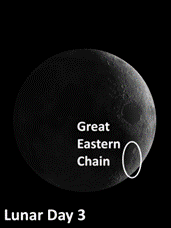The week of September 11-17 takes us from Day 27 to Day 3. This week we will highlight The Great Eastern Chain, viewable on Sunday evening.
 The Great Eastern Chain: [SE/K-N16; L=61°E] There is a conspicuous chain of large moon craters, at one time referred to as the Great Western Chain, which closely hugs the same meridian near the eastern limb (i.e., the rim of the visible disk) of the Moon. They start on the southeastern shore of the Sea of Fertility and continue south1. The chain consists of Langrenus, Vendelinus, Petavius, and Furnerius. These craters started to come into view last night. Although this unusual alignment is coincidental, it was once posited as evidence to support the endogenic theory of crater formation–the now disproven theory that the majority of craters were formed by volcanic forces originating from within the Moon. (Come back on Day 17 when you’ll be able to see them more clearly.)
The Great Eastern Chain: [SE/K-N16; L=61°E] There is a conspicuous chain of large moon craters, at one time referred to as the Great Western Chain, which closely hugs the same meridian near the eastern limb (i.e., the rim of the visible disk) of the Moon. They start on the southeastern shore of the Sea of Fertility and continue south1. The chain consists of Langrenus, Vendelinus, Petavius, and Furnerius. These craters started to come into view last night. Although this unusual alignment is coincidental, it was once posited as evidence to support the endogenic theory of crater formation–the now disproven theory that the majority of craters were formed by volcanic forces originating from within the Moon. (Come back on Day 17 when you’ll be able to see them more clearly.)
Langrenus & Vendelinus: [SE/K-L16; L=61°E] These moon craters are the first two segments of the Great Eastern Chain. Langrenus and Vendelinus are two large 90-mi. craters located on the southeast shore of Fertility. One is considerably older than the other and appeared before the lava flows started. It should be easy for you to decide which is which2.
The terraces and central peaks of Langrenus will have emerged from last night’s shadows, and tonight the crater is a beautiful sight. Even if you have a small telescope, there is much detail in the interior and on the outer ramparts to keep you busy. Because the appearance of the crater changes significantly with different lighting angles, make some drawings of what it looks like tonight and come back over the next few nights to compare the views.
The younger moon crater Lamé intrudes on Vendelinus on its NE rim, and it is appropriately smaller. However, notice that Lamé, in turn, overlaps two smaller unnamed craters on its SW rim. This is unusual in that intruding craters are almost always smaller than the craters they impact on.
OF ADDITIONAL INTEREST IN SPACE
On Monday, Venus is 11° south of the Moon.
New Moon is on Wednesday.
On Saturday, Mars is 0.7° south of the Moon.
1 Its official (and somewhat cumbersome) name is Mare Fecunditatis. I prefer the simplicity of “Fertility” and will use it throughout this Guide.
2 Because it is so heavily worn and has had time to acquire many overlapping smaller craters, Vendelinus is the older.
======================
It is highly recommended that you get a copy of Sky and Telescope’s Field Map of the Moon, the very finest Moon map available for use at the telescope. It is available for $10.95 at www.skyandtelescope.com and on Amazon. All features mentioned in this blog will be keyed to the grid on the Field Map and will look like this: Plato: [NW/D9]
Credits:
Courtesy of Gray Photography of Corpus Christi, Texas
Lunar photos: NASA / USGS / BMDO / LROC / ASU / DLR / LOLA / Moon Globe. Used by permission
- Rupes Cauchy: A Best Known Fault on the Moon - July 22, 2024
- Moon Crater Schickard – Crater Floor has Stripes - July 15, 2024
- Moon Craters Langrenus and Vandelinus - July 8, 2024